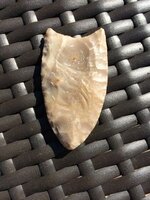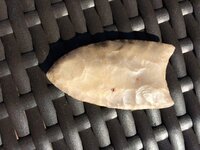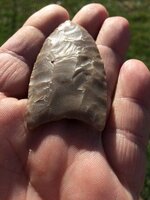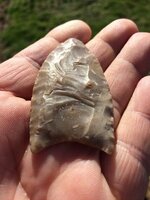Navigation
Install the app
How to install the app on iOS
Follow along with the video below to see how to install our site as a web app on your home screen.
Note: This feature may not be available in some browsers.
More options
You are using an out of date browser. It may not display this or other websites correctly.
You should upgrade or use an alternative browser.
You should upgrade or use an alternative browser.
Texas Clovis
- Thread starter The Grim Reaper
- Start date
The Grim Reaper
Gold Member
- Thread starter
- #2
Yea or nay, and why.
diggingthe1
Silver Member
- Feb 11, 2015
- 2,570
- 6,004
- Detector(s) used
- Minelab EQ800, Ex2
- Primary Interest:
- All Treasure Hunting
I would say yea in the field and nay if it was on a table. I'm definatly a novice when it comes to identification. It would seem like the flaking would be more parallel. Just me and my input. Beautiful point!
joshuaream
Silver Member
I'd pass on it. It looks like it was made by someone who hasn't been knapping very long (not a knock, it's better than I can do), or someone who has simply looked at 2 dimensional pictures of clovis points vs handling them.
tiggerd100
Jr. Member
- Jun 19, 2013
- 71
- 94
Way too fresh for a Clovis. Those chips are from last week
oxbowbarefoot
Banned
Anyone have a known authentic point of the same lithic material to compare patina?
monsterrack
Silver Member
- Apr 15, 2013
- 4,419
- 5,817
- Detector(s) used
- Garrett, and Whites
- Primary Interest:
- All Treasure Hunting
Grimm you have read my mind, I have been doing some studies on Clovis point's just lately. I am a long way of being a good judge no doubt . What I see is that the flute looks to be wrong has if it was made after the convex of the base was made. Also where the flute starts at, the base looks to be to thick and as it was said a few of the hinge nails look way to loose to be real old, but you can't hold that theory to be the truth all the time for southern points. Also it may be just the photo but it does not look to be much grinding on the base. I use to believe that the flute was the last thing done on a Clovis but that is not true from what I have read. I would say nay, but I will follow this closely because I can always learn more anytime.
Last edited:
The Grim Reaper
Gold Member
- Thread starter
- #9
Thanks for the replies guys. I am going to let it go a little more to see who else chimes in. I'm hoping mogi sees this and gives me his opinion. Not singling him out, I'd just like his thoughts on this Clovis Point along with anyone else who wants to weigh in.
Last edited:
Dimensions don't match for an unresharpened Clovis and if it's resharpened then the flaking (or faking?!?!?) doesn't look right. Also, is the base ground? Often on Texas points one side mineralized and/or patina yes differently than the other. No sand polish if it was a west Texas find. I'm on my phone but I also don't see any outré-passé or overshot which is a question.
RockinIdaho
Full Member
Not. There is not any dirt on it. Plus I don't think the shape is quite long enough.
T.C.
Bronze Member
- May 17, 2012
- 2,417
- 3,796
- Detector(s) used
- Whites M6
- Primary Interest:
- All Treasure Hunting
" Not singling him out, I'd just like his thoughts on this Clovis Point along with anyone else who wants to weigh in."
Yeah, I think you are singling him out. He seems to have gotten under your skin hasn't he? You're just waiting to dazzle him with your superior knowledge....ain't cha?? You're quite a guy. By the way, I like the point and really don't care if it is fake or not.
Yeah, I think you are singling him out. He seems to have gotten under your skin hasn't he? You're just waiting to dazzle him with your superior knowledge....ain't cha?? You're quite a guy. By the way, I like the point and really don't care if it is fake or not.
Jon Stewart
Bronze Member
- Jan 11, 2011
- 1,029
- 932
My very first thought when I looked at the photo was, modern, but what do I know except I really like knapping Edwards rock. lol
PaDirtDigger
Hero Member
- Feb 2, 2015
- 950
- 1,278
- Detector(s) used
- White's XLT (2), Garrett Ace 250, Garrett AT Pro, Garrett AT Gold
- Primary Interest:
- All Treasure Hunting
I'm going to chime in with a Nay on this piece. Im a modern knapper, and the flaking and chipping seem like that of copper tools. As others said, no basal grinding either, the whole thing gives off a more "round" shape than anything, From the ears to the tip.... Also, that material looks to be either cooked or simply higher grade. The Clovis people would had that knife/point, made a lot nicer i do believe with the better rock.
Just my 3 cents....
Just my 3 cents....
The Grim Reaper
Gold Member
- Thread starter
- #16
Okay, the Point is definitely fake and everyone pretty much nailed it. My brother bought this n a collection back when he first started buying and selling collection he would pick up at farm auctions. He got burned a few times before he finally knew what to look for. I put this to prove a point that you can spot an obvious fake fairly easily if you know what to look for. Points were for the most part made a certain way. There are certain attributes that each example will possess. Folsoms were pretty much all made with the same technique no matter how far apart they were found. Same with Clovis, Lost Lakes, Thebes, etc. There are certain traits that appear on each authentic piece no matter who knapped them and most modern knappers just don't capture it.
Sorry if there was any confusion that I thought this may be a good piece.
Sorry if there was any confusion that I thought this may be a good piece.
Top Member Reactions
-
 1936
1936 -
 1050
1050 -
 977
977 -
 970
970 -
 873
873 -
 831
831 -
 818
818 -
 784
784 -
 696
696 -
 599
599 -
 378
378 -
 374
374 -
 352
352 -
 348
348 -
 335
335 -
 333
333 -
E
326
-
 309
309 -
 290
290 -
 278
278
Users who are viewing this thread
Total: 2 (members: 0, guests: 2)









